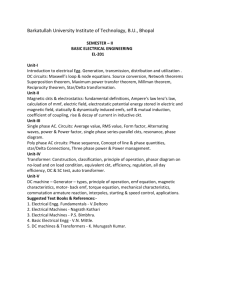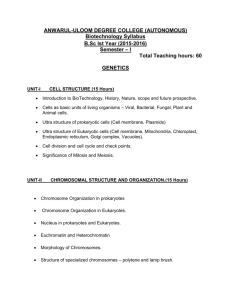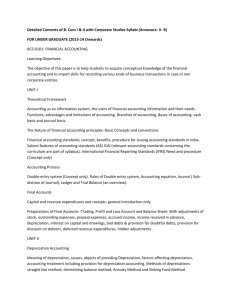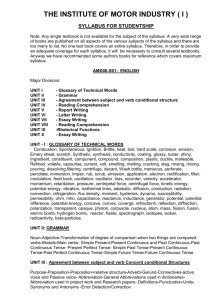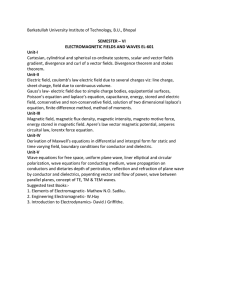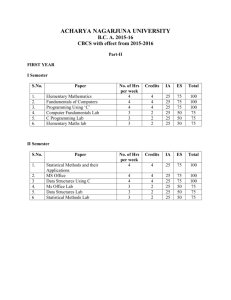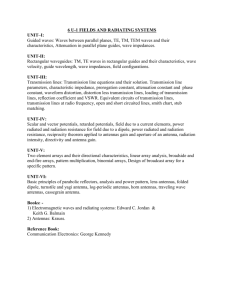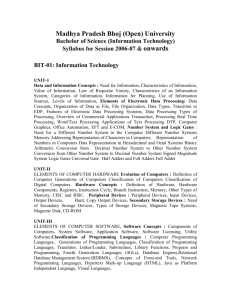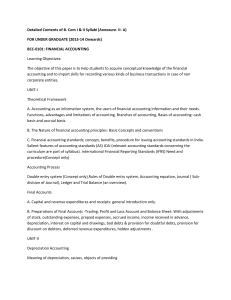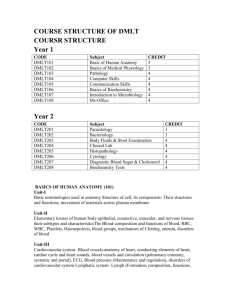courses of studies m.a. (economics) 2015-2016
advertisement
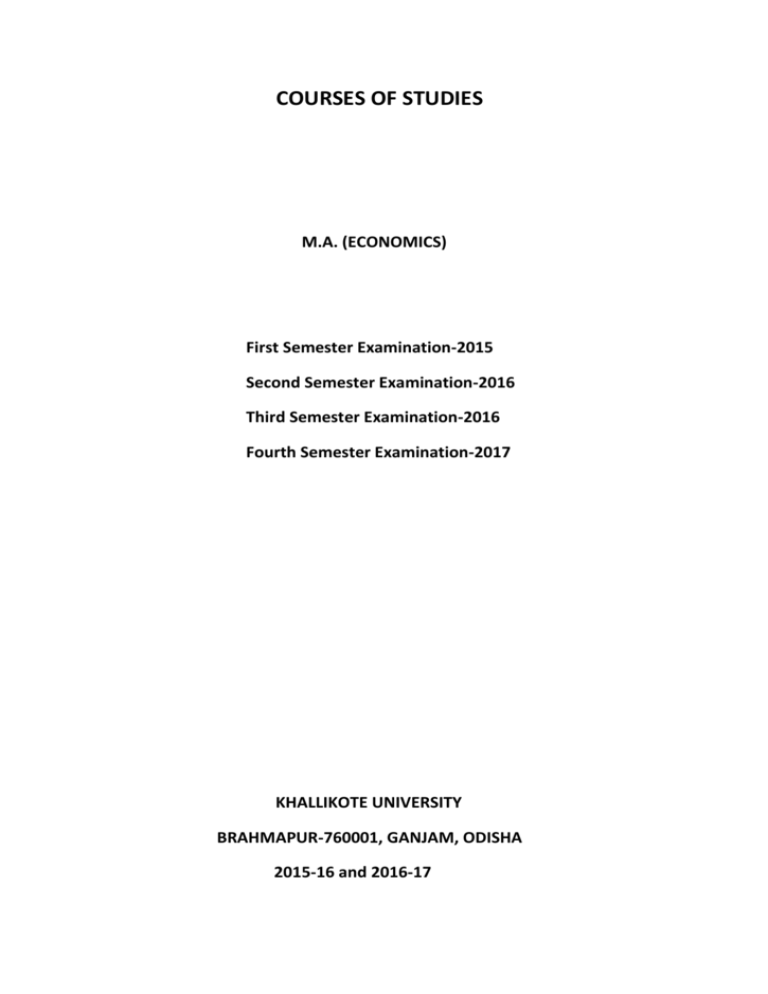
COURSES OF STUDIES M.A. (ECONOMICS) First Semester Examination-2015 Second Semester Examination-2016 Third Semester Examination-2016 Fourth Semester Examination-2017 KHALLIKOTE UNIVERSITY BRAHMAPUR-760001, GANJAM, ODISHA 2015-16 and 2016-17 FIRST SEMESTER PAPER-1.1 MICRO ECONOMIC ANALYSIS-I UNIT-I Theory of consumer behaviour: The basic economic problems; problems of scarcity and choice, The concept and measurement of utility –cardinal and ordinal; Theory of consumer choice-Marginal utility theory and indifference curve approach, consumer’s equilibrium, income effect, price effect and substitution effect, derivation of demand curve; Revealed Preference Theory, Concept of Consumer’s surplus and its measurement, Hicksian rehabilitation of the concept of consumer surplus, Consumer’s choice under risk and uncertainty. UNIT-II Theory of Producer Behaviour: Production function — short period and long period;Returns to variable proportions, law of variable proportions, Isoquants and returns to scale; Producer’s equilibrium, factor price effect, output effect and substitution effect, expansion path, Homogenous Production Function, Cobb-Douglas Production Function and CES production function. UNIT-III Cost Analysis: Concepts on cost, Nature of cost curves in short run and long run and their relationship, Learning curve, L-shaped LAC, Algebraic forms of cost functions, Economies and diseconomies of scale and shape of cost curves. Revenue Analysis: Concepts on revenue, Total, Average and Marginal revenue curves, derivation of supply curve, conditions of equilibrium between revenue and cost. UNIT-IV Market Behaviour-I: Concept, classification and types of markets, price and output determination under perfect competition in short run and long run, price and output determination under monopoly both in short run and long run, Discriminating monopoly, price and output determination under discriminating monopoly, Comparison between monopoly and perfect competition. PAPER-1.2 MACRO ECONOMIC ANALYSIS-I UNIT-I Circular flow of income in two, three and four sector economy; Concepts of National Income and its measurement, Product, income and expenditure method, Value added vrs final goods method; General problems of computing National Income in developed and developing economies. Social accounting-Input output accounting, flow of funds accounting, Balance of payments accounting. UNIT-II Classical macro model, Say’s law of market and its implications, Critical appraisal of classical macro model. Basic Keynesian model, Aggregate demand, Determination of equilibrium level of income, Comparison of Classical and Keynesian macro model, Relevance of Keynes macro model in the modern economy, Failure and weaknesses of Keynesian theory. UNIT-III Consumption function, Keynes psychological law of consumption, Implication of short run and long run consumption, Factors affecting consumption, Income-consumption relationship, Static & dynamic consumption function, Importance of consumption function. Theories of consumption, Absolute, Relative, life cycle and Permanent income Hypothesis. Investment function, Autonomous and induced investment, Factors affecting investment, MEC, Factors affecting MEC. UNIT-IV Inflation and deflation- Approaches to the theory of inflation, Causes of inflation, Cost-push and demand-pull inflation, Inflationary Gap, Effects of inflation-economic and non-economic effects, Measures to control of inflation, Inflation in an underdeveloped country. Deflation-Effects and Control of Deflation in an economy. Monetary Policy-Objectives and instruments of monetary policy, Effectiveness of monetary policy during inflation and deflation, Monetary policy in Underdeveloped countries. Fiscal Policy- Objectives and effectiveness of fiscal policy in realising the objectives, Fiscal policy in underdeveloped countries. PAPER-1.3 QUANTITATIVE METHODS-I UNIT-I Concept of function and types of functions; Limit, continuity and derivative; Rules of differentiation; Application of derivative in revenue and cost, demand functions; Elasticity and their types; Rules of partial differentiation and interpretation of partial derivatives; Application of partial derivatives in production function. UNIT-II Problems of maxima and minima; Unconstrained and constrained optimization in simple economic problems relating utility, cost, revenue, profit and production. Concept of integration; Simple rules of integration; Application of integration in revenue and cost functions, Definite Integrals and their properties, Application to consumer’s surplus and producer’s surplus; Compound Interest, Present value and Capital value. UNIT-III Matrix and determinants: Concept of determinants and their basic properties, Solution of simultaneous equations using Cramer’s rule. Concept of matrix and their types, simple operations on matrices, matrix inversion and rank of a matrix; Application of matrix to solve simultaneous equations and in Input-Output Analysis. UNIT-IV Linear programming — Basic concept; Formulation of a linear programming problem — Its structure and variables; Nature of feasible, basic and optimal solution; Solution of linear programming through graphical and simplex method. Formulation of the dual of a programme and its interpretation; Shadow prices and their uses; Concept of duality and statement of duality theorems; Concept of a game; Strategies — simple and mixed; Value of a game; Saddle point solution. PAPER-1.4 PUBLIC ECONOMICS-I UNIT-I Role of Government in organized society; Government in a mixed economy: Normative approach to public finance- Allocation, Distribution and Stabilisation branch, Inter-sectoral resource allocation, Optimal allocation of resources between public and private sector, Government as an agent for economic planning and development; Government as a tool for operationalizing the planning process; private goods, public goods, and merit goods; Market failure — imperfections, decreasing costs, externalities, Mixed goods and merit goods. UNIT-II Optimum provision of public goods, Lindahl-Johansen model, Samuelson’s pure theory, Musgrave’s Voting model and collective choice, Arrow’s impossibility theorem; Wagner’s law of increasing state activities; Wiseman- Peacock hypothesis; Pure theory of public expenditure; Structure and growth of public expenditure; Criteria for public investment. UNIT-III Theory of incidence; Alternative concepts of incidence — Allocative and equity aspects of individual taxes; Benefit and ability to pay approaches; Theory of optimal taxation; Excess burden of taxes; Trade off between equity and efficiency; The problem of double taxation. UNIT-IV Indian tax system; Revenue of the Union, States and local bodies; Major taxes in India: base of taxes, direct and indirect taxes, expenditure tax, reforms in direct and indirect taxes, taxes on services; Non-tax revenue of Centre, State and local bodies. PAPER-1.5 HISTORY OF ECONOMIC THOUGHT-I UNIT-I Mercantilism: Factors responsible for growth of Merchantilism, Basic philosophy of Merchantilists-Balance of Trade on Growth, Employment, population, Interpretation of Mercantilism. Physiocracy : Rise of Physiocratic ideas, Basic principles and policies, Natural Order, Net Product, Circulation of wealth (Tableau Economique), Taxation and Trade, Physiocracy and Modern economics. UNIT-II Classical Economics: Adam Smith- Naturalism and optimism, Adam Smith’s theory of value, distribution and growth. David Ricardo- Theory of value and rent. T.R.Malthus- Theory of population, Theory of glut. UNIT-III J.S.Mill- Ideas on production, distribution and rise of Socialistic ideas. J.B.Say-Say’s law of markets. Crtics of classical economics-Sismondi & Frederic List. UNIT-IV Karl Marx: Dialectical Materialism, Theory of Surplus value, Capital accumulation, Falling rate of profit, Crisis under capitalism, Decay of capitalism, Marx-a false prophet. SECOND SEMESTER PAPER-2.1 MICRO ECONOMIC ANALYSIS-II UNIT-V Market Behaviour-II: Price and output determination under monopolistic competition, Price and output competition, Chamberlin’s approach of selling cost and Individual and group equilibrium, effects of selling cost on demand, Determination of optimum selling cost under monopolistic competition, Excess capacity under monopolistic competition. Oligopoly-Basic market structure, collusive and non-collusive oligopoly, cartels, Price and output determination under Oligopoly, Duopoly, Cournot solution, Stackelberg solution and kinked demand curve, Market sharing solution and Price leadership. UNIT-VI Theory of factor pricing-I: Marginal productivity theory of distribution under perfect and imperfect competition, Determination of rent-Ricardian and Modern theory of Rent, Modern theory of wage determination, Pricing of labour under imperfect competition, Exploitation of labour, Role of trade union and collective bargaining in wage determination. UNIT-VII Theory of factor pricing-II: Determination of Interest- Classical, neo-classical and Liquidity preference theory. Determination of Profit- Clark, Schumpeter and Knight’s theory of profit. UNIT-VIII Welfare Economics: Classical social welfare, Pareto optimality conditions; Problem of welfare maximisation, Compensation principle. Partial and General equilibrium, Stability of equilibrium, Walrasian model. PAPER-2.2 MACRO ECONOMIC ANALYSIS-II UNIT-V Classical approach and Keynesian approach to demand for money-Transaction, precautionary and speculative demand, Liquidity preference theory, Quantity theory approach- Fisher’s transaction equation, Cambridge version and income expenditure approach. Real balance effect by Patinkin, Friedman’s reformulation of quantity theory. UNIT-VI Rate of interest: Classical theory, Loanable Funds theory, Keynes liquidity preference theory, Reconciliation of Loanable funds and liquidity preference, General Equilibrium- IS-LM Model, and rate of interest, Equilibrium in money market. UNIT-VII Concept of money supply, four measures of money supply, Determinants of money supply, High powered money, Money multiplier. Accelerator- Working, importance and Limitations of Accelerator, Multiplier and Accelerator interaction in income generation. UNIT-VII Business Cycles-Phases and Features of business cycle, Theories of Business cycle- Hawtrey, Hayek, Schumpeter, Hicks and Samuelson. Control of Business cycles- Relative efficacy of monetary and fiscal policy. PAPER-2.3 QUANTITATIVE METHODS-II UNIT-V Correlation Analysis: Meaning, assumptions and limitations of simple correlation; Pearson’s product moment and spearman’s rank correlation coefficients and their properties; Partial and multiple correlation. Regression Analysis: Concept of regression, the least squares and the lines of regression; Fitting regression lines using two variables, Standard error of estimate; Coefficient of determination. UNIT-VI Probability: Concept, classical and empirical definitions of probability, deterministic and nondeterministic experiments, various types of events, Laws of addition and multiplication, conditional probability, simple problems relating probability. UNIT-VII Basic concept of sampling — random and non-random sampling; Simple random; stratified random, P.P.S. sampling-their merits and demerits. Probability distributions: Properties of Binomial, Poisson and Normal distribution. UNIT-VIII Concept of an estimator and its sampling distribution; Desirable properties of an good estimator; Formulation of statistical hypotheses — Null and alternative; Confidence intervals and level of significance; Hypothesis testing based on Z, t, x2 (Chi-square) and F tests; Type I and Type II errors. PAPER-2.4 PUBLIC ECONOMICS-II UNIT-V Classical view of public debt; Compensatory aspect of debt policy; Burden of public debt; Sources of public debt; Debt through created money; Public borrowings and price level; Crowding out of private investment and activity; principles of debt management and methods of repayment. UNIT-VI Budget: Purpose and principles of budget preparation, Deficit budget, Surplus budget, Balanced and unbalanced budget, PPBS, Balanced budget multiplier. UNIT-VII Objectives of fiscal policy — full employment, anti-inflation, economic growth, redistribution of income and wealth; Interdependence of fiscal and monetary policies; Budgetary deficits and its implications; Fiscal policy for stabilization — automatic vs. discretionary stabilization; Alternative measures of resource mobilization and their impact on growth, distribution and prices. UNIT-VIII Fiscal federalism in India; Vertical and horizontal imbalance; Assignment of function and sources of revenue; Constitutional provisions; Finance Commission and Planning Commission; Devolution of resources and grants; Theory of grants; Resource transfer from Union to States — Criteria for transfer of resources; Centre-State financial relations in India; Report of recent most Finance Commission of India. PAPER-2.5 HISTORY OF ECONOMIC THOUGHT-II UNIT-V Austrian School: Karl Monger, Von Wieser and Bohm Bowerk. Margianalist School: Features of maeginalism, Hermann Gossen, W.S.Jevons and J.B.Clark. UNIT-VI Mathematical School: A Cournot, Gustav Cassel, Economic ideas of K.Wicksell, Alfred Marshall, Veblen’s ideas of institutional economics. UNIT-VII Economic ideas of J.M.Keynes, Theory of employment, Keynes views on Development, Savings,Investment, Rate of interest and Multiplier. Post Keynesian Developments-Supply underdeveloped economies. side economics, Monetarism;Keynes and UNIT-VIII Contributions of Schumpeter, Nurkse and W.W.Rostow. Economic ideas of Mahatma Gandhi, Jawaharlal Nehru and Amartya Sen.
